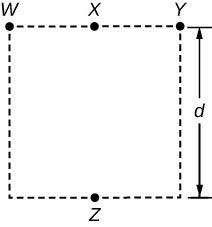Question
What is the magnitude of the net force exerted on object X by objects W, Y, and Z?
- F/4
- F/2
- 9F/4
- 3F

Final Answer
(a)
Solution video
OpenStax College Physics for AP® Courses, Chapter 18, Problem 40 (Test Prep for AP® Courses)

vote with a rating of
votes with an average rating of
.
Video Transcript
This is College Physics Answers with Shaun Dychko. Four charges are arranged as shown here on this square and they each have a magnitude of charge of plus q and this point X and this point Z are the mid-points of their respective sides, the side-length is d and we are asked to find out what is the net force on X knowing that the force on X due to the charge at W is F so the magnitude of the force due to charge W is F. And that's going to be a force to the right the charge Y will exert an equal magnitude force in the opposite direction and so these two forces are going to cancel out and so the net force is going to be only this force due to charge Z on the opposite side of the square. So what is this magnitude of this force in terms of F? Well, F we know is going to be kq squared because each charge is q so multiplying them together gives us q squared divided by the distance between X and W which is side length over 2 squared and we can multiply top and bottom of this by 4 and we end up with 4kq squared over d squared. Okay! And the force due to Z is going to be kq squared over the distance between Z and X, which is the full distance d squared and kq squared over d squared, we could solve for that here and by dividing both sides by 4— this being one side and the other side being just the F here— and we have F over 4 then is going to be the force due to Z. So the answer is (a).